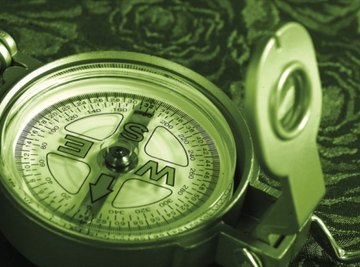
Different directional compasses bear different markings. Some compasses are marked off to display a full 360 degrees, and some are marked in gradations of 20 degrees. Some also display a "declination." The declination is a means of showing the difference between magnetic north and true north. The magnetic north pole is in a different place than the geographic north pole, so you should buy a compass that is properly declined for your area, or one with adjustable declination. Declination is given in degrees, so this gives you one more good reason to learn how degrees work.
The end of the needle that points North should be colored red, so make sure that the red tip rests on North when reading your compass.
Look at your compass and take note of how it is marked. If your compass has 359 degree marks, then it probably has special marks at every 10th degree. While it is understood that every circle contains 360 degrees, not 359, the 360 mark on many compasses is replaced by a 0. If your compass is marked in gradations -- for instance, marked off in 20-degree regions -- then it will be easier to read but less precise.
Find the declination of your compass. If your compass is declined West, subtract the declination from 0 to find true North. If your compass is declined East, add the declination to find true North. Add 90 to declined North to find declined East, and repeat for declined South and West.
Find the remaining directions by finding the midpoints between each amount. If 0 degrees is North and 90 degrees is East, then 45 degrees is Northeast. This applies for every adjacent pair of directions, so the midpoint between East (90) and South (180) is Southeast at 135 degrees. Remember to decline North first and then find midpoints, so you don't have to decline all eight directions.
Read your compass by turning it until the N mark matches the direction of the needle, then rotate again to compensate for your declination. Find the degree mark that points the way you're facing, and add up the degrees between this mark and the nearest of the eight directions; that's your orientation. Then find the nearest cardinal direction.
Read your orientation, followed by the nearest cardinal direction, followed by the nearest of the eight directions. For example, say your orientation is 230 degrees. The nearest of the eight directions is Southwest at 225 degrees, which is five degrees lower, and the nearest cardinal direction is West. Read this as 5 degrees West-Southwest. If your orientation had been 220 degrees, you would read it as 5 degrees South-Southwest.
Tips
References
Tips
- The end of the needle that points North should be colored red, so make sure that the red tip rests on North when reading your compass.
About the Author
Ben Beers began writing professionally in 2010. He has written content for Zemandi.com and Dorrance Publishing, Inc. He studied anthropology at Miami University before leaving to write professionally.
Photo Credits
Photos.com/Photos.com/Getty Images
